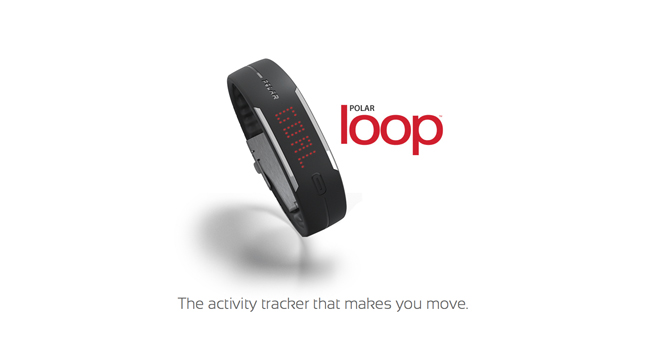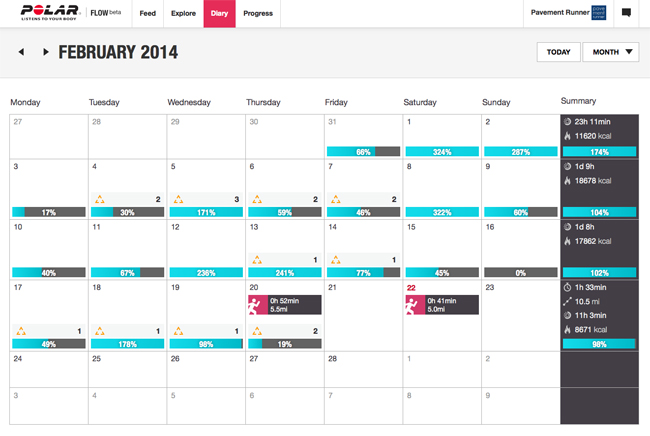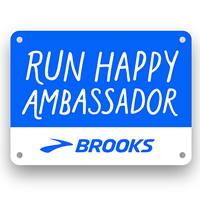The following post is sponsored by Fitfluential LLC on behalf of Polar.
I run a lot of miles. It is not uncommon for me to run 8 miles on any given day in the middle of the week, but how “active” am I outside of my running? That is something I was interested in finding out as part of this campaign with Polar to #rethinkyourday.
I was given the opportunity to try out their Polar Loop. It’s a bracelet, or band, that tracks your activity 24/7 at five intensity levels: resting. sitting, low (being UP), medium (such as walking) and high (such as running). It can also keep track of the amount of hours you are sleeping.
I have been wearing the Polar Loop for most of the month of February. I have been pretty excited about seeing how many steps I’m tracking a day — and I’ve been wearing it while I run. I think the furthest I went was over 25,000 steps. That sounds FAR! Looking back at the month, it was clear that on days that I run, I surpassed my goal. On days when I was not running, my activity was low. I didn’t have too many “notices” (those little yellow triangles) where I was inactive for more than an hour, but there were a few… even on days when I did run. I sit between the hours of 9-5, but do a good job of getting up and moving around throughout the day.
Breaking down a day
Here is a look at a Saturday. If you take a look at between midnight and about 7 am, there are a few blips of activity. That means that there was some restless sleep going on. I think around 3 am, either the First Lady got up and I had to hold her to fall back asleep, or I had to go to the bathroom. LOL. I don’t remember, but something happened. The rest of the day is fairly filled with activity throughout the day — a good combination of sitting and being up. I also got in a 10.5 mile run at 2 o’clock. The rest of the day is good pattern of mixed activity.
Below here, let’s take a look at a day in the middle of the week where I went for a run (LEFT) vs. when I did not (RIGHT) . It is obvious that when you remove a run from my day, my activity level drops significantly. Although, there are more notices on the day when I DID run vs. when I did not. However, two of those happened when I was blogging late at night — yep, I stay up until midnight on the computer sometimes.
Overall Impression:
- It is really “light” on the wrist… less than the weight of typical watch.
- Fashionable. It looks sweet in sheek black with silver lining.
- Bluetooth – it syncs to the mobile app fairly easily for a constant update
- Ease of use – with the press of a button, you can see the time, steps, CALS and activity on the band.
- Sleep friendly. I thought it would bother me while I slept, but it was unnoticable.
- Incredible battery life. I keep thinking it’s going to wear out, but it holds a charge well and recharges SUPER fast, 5-10 mins.
Polar H7 Heart Rate Sensor
I also had the chance to test out the Polar H7 Heart Rate Sensor. This was something extremely new to me as I have never used a HRM. I feel like a fancy runner. I’ve read a lot about them in helping you to find and keep track of your optimal training zone. I’ve only used this twice, but I’m looking forward to working it into more of my workouts.
It straps on pretty easily, almost to the point where I feel like it should have more buttons and straps. But you simply add a little moisture to the band, and slide a hook over a band and it holds. I run with a hydration pack, so having something tight around my chest didn’t bother me. It didn’t chafe or irritate me, which was good. It held up during my two 50-minute runs and didn’t slip or slide around. It works through Bluetooth with your a mobile device and it synced to my iPhone really easily. I used the Polar Beat App to track my runs and the user experience was really easy. It also gave me feedback on my heart rate before I started running, so that I had peace of mind that it was already tracking me.
If you take a look at one of my recent lunch hour runs, you can see that during my 52 minute run, I was in zone 4 for over half of the time. With a warm up and cool down mile, that means that the majority of my run was at an optimal pace with Polar Beat describing it as a “tempo training.”
I’m really excited about using this more often throughout my training and I definitely need to learn more about when I should be in the different zones of the heart rate chart.
Update: I forgot to mention that the Polar Loop and the Heart Rate Sensor operate independently of one another. The Heart Rate Sensor does not send details or information to the Polar Loop Bracelet. Polar also makes several Heart Rate Sensors that work with various products and fitness apps.
Do you count your steps or use a Heart Rate Sensor?















I don’t use a heart rate monitor, but I am curious to see my activity broken down like that’s! I think I am pretty inactive outside of running and cycling.
Wow! That was such an interesting read!!! I have been so curious about this the last few weeks, and now I have found a review from someone I feel is able to relate on a similar level to my training. I run average of 10 miles a day, and as an elite, I am looking for the best ways to improve my training, even by just a few seconds, as that can be the difference between making a international team to run in a world championship….and not. This polar loop caught my eye, and I am so jealous you had the opportunity to try it out!!!!
That is a great review! I am thinking that I should consider it. I know how to use heart rate zones to improve my training, and I would be curious to see if I am active enough throughout the rest of my day. It would be very helpful for seeing if I am balancing my rest right too!
Thanks for the recap!
Really great review! I love how your really broke it down and showed how it worked. I have always wanted to try one of these but unfortunately it is not in the budget :( Maybe one day!! Looks like an amazing product!
I use a heart rate monitor during my daily bootcamp style workout, but not when I go running in the afternoons. During the workout I can see my heart rate on the one of the monitors as well as the calorie burn. It is very interesting to see how the different workouts affect your heart rate and the number of calories that you burn. I used it for running a few times, but did not see much benefit from it as I think it adds too much complexity if you want to adjust your running based on your heart rate.
I like the HR monitor too, though I’ve noticed that it misses a lot of my activity. For example, I’ll wear it for 3 hours while teaching. I am definitely moving and have a heart beat. But when I download the info, it will only show an hour. So something’s not right. In the end, I still like it, and have just adjusted to its quirks.
That Polar Loops looks pretty cool. Technology is amazing I tell ya!
I wonder if this would track activities where you are not moving. For example: I love spin, but you and the bike stay in one place, would it know you had moved if it works without the HR strap.
I don’t use any tracker but it would be fun to see it in action for my off days since I know my workout days are hard core. :)
I’ve never used a heart rate sensor or pedometer before, but I’ve noticed that they seem to be increasingly popular right now. This one by Polar, along with the Fit Bit and a model planned (or already out now) from Garmin are all competing for attention. I will say that the end goal for any of these products is good: helping people become less sedentary and more active.